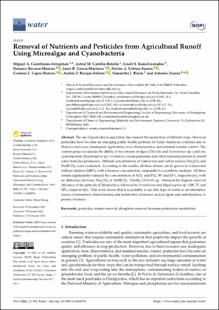Removal of Nutrients and Pesticides from Agricultural Runoff Using Microalgae and Cyanobacteria
Artículo de revista
2022-02-12
Water (Switzerland)
Suiza
The use of pesticides in agriculture has ensured the production of different crops. However,
pesticides have become an emerging public health problem for Latin American countries due to
their excessive use, inadequate application, toxic characteristics, and minimal residue control. The
current project evaluates the ability of two strains of algae (Chlorella and Scenedesmus sp.) and one
cyanobacteria (Hapalosyphon sp.) to remove excess pesticides and other nutrients present in runoff
water from rice production. Different concentrations of wastewater and carbon sources (Na2CO3 and
NaHCO3
) were evaluated. According to the results, all three strains can be grown in wastewater
without dilution (100%), with a biomass concentration comparable to a synthetic medium. All three
strains significantly reduced the concentration of NO3 and PO4
(95 and 85%, respectively), with
no difference between Na2CO3 or NaHCO3
. Finally, Chlorella sp. obtained the highest removal
efficiency of the pesticide (Chlorpyrifos), followed by Scenedesmus and Hapalosyphon sp. (100, 75, and
50%, respectively). This work shows that it is possible to use this type of waste as an alternative
source of nutrients to obtain biomass and metabolites of interest, such as lipids and carbohydrates, to
produce biofuels.



 PDF
PDF
 LEER EN FLIP
LEER EN FLIP













